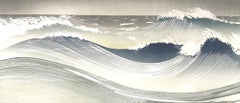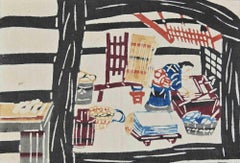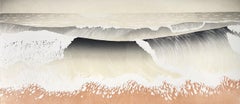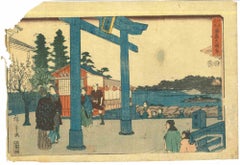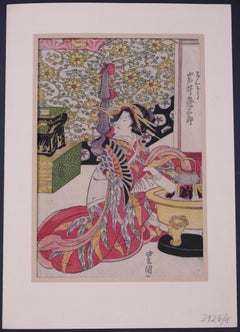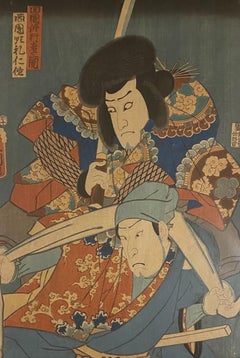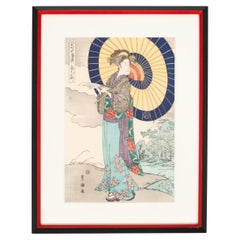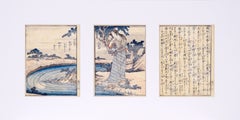Japanese Woodcut Art
21st Century and Contemporary Contemporary Landscape Prints
Paper, Woodcut
Mid-20th Century Modern Figurative Prints
Woodcut
21st Century and Contemporary Contemporary Landscape Prints
Paper, Woodcut
19th Century Modern Figurative Prints
Woodcut
1850s Modern Portrait Prints
Paper, Woodcut
19th Century Figurative Prints
Woodcut
Mid-20th Century Modern Figurative Prints
Woodcut
Mid-20th Century Japanese Showa Prints
Paper
Early 19th Century Edo Figurative Prints
Paper, Ink, Woodcut
Late 19th Century Modern Figurative Prints
Woodcut
21st Century and Contemporary Contemporary Landscape Prints
Paper, Woodcut
19th Century Modern Figurative Prints
Woodcut
1960s Abstract Abstract Prints
Woodcut, Paper
19th Century Interior Prints
Woodcut
1860s Edo Figurative Prints
Woodcut
1850s Impressionist Figurative Prints
Rice Paper, Woodcut
1850s Figurative Prints
Woodcut
1850s Impressionist Figurative Prints
Rice Paper, Woodcut
2010s Modern Mixed Media
Paper
1850s Edo Figurative Prints
Paper, Pigment, Woodcut
2010s Abstract Mixed Media
Paper
1920s Edo Landscape Paintings
Paper, Ink, Woodcut
1990s Japanese Other Decorative Art
Glass, Wood, Paint, Paper, Parchment Paper
Vintage 1950s Japanese Other Decorative Art
Paint, Paper, Parchment Paper, Glass, Wood
Vintage 1960s Japanese Other Decorative Art
Paint, Paper, Parchment Paper, Glass, Wood
20th Century Modern Landscape Prints
Woodcut
1980s Modern Landscape Prints
Gold Leaf
1860s Landscape Prints
Paper, Woodcut
Vintage 1950s Japanese Other Decorative Art
Paint, Wood, Glass, Paper, Parchment Paper
Antique 1880s Prints
Paper
20th Century Modern Prints and Multiples
Woodcut
20th Century Portrait Prints
Woodcut
Vintage 1960s Japanese Mid-Century Modern Paintings
Paper
19th Century Portrait Prints
Woodcut
1850s Edo Landscape Prints
Woodcut
18th Century Edo Figurative Prints
Ink, Rice Paper, Woodcut
Early 1800s Edo Portrait Prints
Woodcut
19th Century Portrait Prints
Woodcut
19th Century Figurative Prints
Woodcut
1860s Edo Portrait Prints
Woodcut
20th Century Portrait Prints
Woodcut
Early 1900s Naturalistic Animal Prints
Woodcut
1950s Modern Figurative Prints
Woodcut
1890s Edo Landscape Prints
Handmade Paper, Mulberry Paper, Woodcut
1840s Edo Figurative Prints
Mulberry Paper, Woodcut
20th Century Figurative Prints
Woodcut
19th Century Portrait Prints
Woodcut
19th Century Portrait Prints
Woodcut
1880s Edo Figurative Prints
Paper, Ink, Woodcut
Early 1900s Showa Figurative Prints
Woodcut
1890s Other Art Style Figurative Prints
Woodcut
1830s Edo Figurative Prints
Woodcut
19th Century Figurative Prints
Woodcut
1890s Edo Landscape Prints
Ink, Rice Paper, Woodcut
1780s Edo Figurative Prints
Woodcut
Mid-20th Century Realist Figurative Prints
Woodcut
2010s Showa Figurative Prints
Woodcut
Mid-20th Century Figurative Prints
Paper, Woodcut
1920s Edo Figurative Prints
Ink, Rice Paper, Woodcut
Late 19th Century Portrait Prints
Woodcut
- 1
- ...
Japanese Woodcut Art For Sale on 1stDibs
How Much is a Japanese Woodcut Art?
Finding the Right Prints-works-on-paper for You
Decorating with fine art prints — whether they’re figurative prints, abstract prints or another variety — has always been a practical way of bringing a space to life as well as bringing works by an artist you love into your home.
Pursued in the 1960s and ’70s, largely by Pop artists drawn to its associations with mass production, advertising, packaging and seriality, as well as those challenging the primacy of the Abstract Expressionist brushstroke, printmaking was embraced in the 1980s by painters and conceptual artists ranging from David Salle and Elizabeth Murray to Adrian Piper and Sherrie Levine.
Printmaking is the transfer of an image from one surface to another. An artist takes a material like stone, metal, wood or wax, carves, incises, draws or otherwise marks it with an image, inks or paints it and then transfers the image to a piece of paper or other material.
Fine art prints are frequently confused with their more commercial counterparts. After all, our closest connection to the printed image is through mass-produced newspapers, magazines and books, and many people don’t realize that even though prints are editions, they start with an original image created by an artist with the intent of reproducing it in a small batch. Fine art prints are created in strictly limited editions — 20 or 30 or maybe 50 — and are always based on an image created specifically to be made into an edition.
Many people think of revered Dutch artist Rembrandt as a painter but may not know that he was a printmaker as well. His prints have been preserved in time along with the work of other celebrated printmakers such as Pablo Picasso, Salvador Dalí and Andy Warhol. These fine art prints are still highly sought after by collectors.
“It’s another tool in the artist’s toolbox, just like painting or sculpture or anything else that an artist uses in the service of mark making or expressing him- or herself,” says International Fine Print Dealers Association (IFPDA) vice president Betsy Senior, of New York’s Betsy Senior Fine Art, Inc.
Because artist’s editions tend to be more affordable and available than his or her unique works, they’re more accessible and can be a great opportunity to bring a variety of colors, textures and shapes into a space.
For tight corners, select small fine art prints as opposed to the oversized bold piece you’ll hang as a focal point in the dining area. But be careful not to choose something that is too big for your space. And feel free to lean into it if need be — not every work needs picture-hanging hooks. Leaning a larger fine art print against the wall behind a bookcase can add a stylish installation-type dynamic to your living room. (Read more about how to arrange wall art here.)
Find fine art prints for sale on 1stDibs today.
- What is a woodcut in art?1 Answer1stDibs ExpertFebruary 22, 2021A woodcut is a process where tools are used to carve a design into a wooden surface. Woodcut is the oldest form of printmaking wherein the wooden carving can be reused to print the same image repeatedly.
- 1stDibs ExpertApril 5, 2022There are a variety of different types of Japanese art. One of the oldest and most admired forms of Japanese art is the art of calligraphy, which originated in the sixth or seventh century. Another type of art, ukiyo-e, is the art of the woodblock print, which depicts scenes of female beauties; kabuki actors, sumo wrestlers and more. You’ll find a variety of Japanese artwork from some of the world’s top art dealers on 1stDibs.
- 1stDibs ExpertApril 5, 2022The writing on Japanese art is calligraphy art called shodo. It uses Japanese kanji and kana characters. There are a variety of different shodo styles of art, including Kaisho, which is the basic, foundational form of the art. On 1stDibs, find a range of Japanese calligraphy art from top sellers..
- 1stDibs ExpertApril 16, 2024The focus of Japanese art varies. Many traditional Japanese artists sought to capture the beauty of nature in their works. However, other Japanese artists have produced work with Buddhist themes, and contemporary artists working in the country have been inspired by a range of subjects, from socioeconomic and political issues to pop culture. On 1stDibs, explore a large selection of Japanese art.
- 1stDibs ExpertSeptember 23, 2024What the Japanese sea art is called depends on its type. Many examples of sea art from Japan are called ukiyo-e. This term refers to woodblock prints made during the 17th, 18th and 19th centuries. The Great Wave off Kanagawa by Katsushika Hokusai is arguably the most famous ukiyo-e print depicting the sea. On 1stDibs, find a wide variety of Japanese woodblock prints.
- 1stDibs ExpertOctober 15, 2024To tell if art is Japanese or Chinese, study the piece's characteristics. With paintings, Chinese artists often use more color and tend to fill their entire canvases, while Japanese artists often include more negative space and choose subtler colors. There are also differences between the brushstrokes typical of traditional Chinese and Japanese art. In Japanese paintings, brushstrokes are often short and sharp. On the other hand, Chinese paintings often display longer, more fluid brushstrokes. Learning about the defining features of various art forms and periods and looking at examples of pieces made by Japanese and Chinese artists can help you learn to spot subtle differences. Explore a diverse assortment of Japanese and Chinese art on 1stDibs.
- 1stDibs ExpertApril 5, 2022Many art styles originated in Japan and grew in popularity over the years. Some of the most popular styles include shodo (calligraphy), ikebana, kanou and yamato-e. You’ll find a wide variety of authentic Japanese art from some of the world’s top dealers on 1stDibs.
- 1stDibs ExpertApril 5, 2022What Japanese wall art is called depends on its type. There are numerous kinds of Japanese paintings and prints, including nihonga and ukiyo-e. A Japanese wall scroll is known as a kakejiku or kakemono. On 1stDibs, find a variety of Japanese wall art.
Read More
Joan Mitchell’s Rare, Late-Career Diptych Buzzes with Life
Beneath the inky blackness, the painter’s irrepressible energy electrifies this pair of intaglio prints.
The 1stDibs Guide to Types of Abstract Art
Get to know the key movements and artists who have influenced visual culture for more than a century.
Romare Bearden’s Humanity Infuses His Bright, Bold Art
Through collage, painting and printmaking, the artist foregrounded Black life in America in revolutionary new ways.
Andy Warhol and Suzie Frankfurt’s ‘Wild Raspberries’ Cookbook Is an Artful, Fanciful Delight
This set of recipes and original prints might not make you a better chef. But it will make you smile.
Art Brings the Drama in These Intriguing 1stDibs 50 Spaces
The world’s top designers explain how they display art to elicit the natural (and supernatural) energy of home interiors.
Welcome (Back) to the Wild, Wonderful World of Walasse Ting
Americans are rediscovering the globe-trotting painter and poet, who was connected to all sorts of art movements across a long and varied career.
Shapero Modern’s Director Tells Us All about 20th-Century Prints
Tabitha Philpott-Kent knows a lot of art multiples. Here, the London gallery director talks about what makes printmaking so fabulous.
Yoshitomo Nara Puts a Punk Rock Twist on the Traditional Prints of His Ancestors
The forever-rebellious Japanese artist craftily defaces famous Edo Period woodblock prints with “In the Floating World.”
